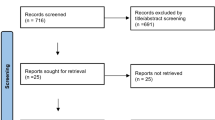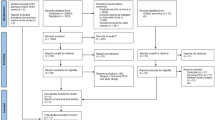Abstract
Post-traumatic hydrocephalus (PTH) is a potentially morbid sequela of decompressive craniectomy for traumatic brain injury (TBI). Subdural hygromas are commonly identified following decompressive craniectomy, but the clinical relevance and predictive relationship with PTH in this patient cohort is not completely understood. Survey of seven electronic databases from inception to June 2019 was conducted following PRISMA guidelines. Articles were screened against pre-specified criteria. Multivariate hazard ratios (HRs) for PTH by the presence of subdural hygroma were extracted and pooled by meta-analysis of proportions with random effects modeling. We systematically identified nine pertinent studies describing outcomes of 1010 TBI patients managed by decompressive craniectomy. Of the overall cohort, there were 211 (21%) females and median age was 37.5 years (range 33–53). On presentation, median Glasgow Coma Scale was 7 (range, 5–8). In sum, PTH was reported in 228/840 (27%) cases, and subdural hygroma was reported in 449/1010 (44%) cases across all studies. Pooling multivariate-derived HRs indicated that subdural hygroma was a significant, independent predictor of PTH (HR, 7.1; 95% CI, 3.3–15.1). The certainty of this association was deemed low due to heterogeneity concerns. The presence of subdural hygroma is associated with increased risk of PTH after decompressive craniectomy among TBI patients based on the current literature and may mandate closer clinical surveillance when detected. Prospective studies, including those of intracranial hydrodynamics following decompressive craniectomy in the setting of TBI, will better validate the certainty of these findings.


Similar content being viewed by others
References
Aarabi B, Hesdorffer DC, Ahn ES, Aresco C, Scalea TM, Eisenberg HM (2006) Outcome following decompressive craniectomy for malignant swelling due to severe head injury. J Neurosurg 104:469–479. https://doi.org/10.3171/jns.2006.104.4.469
De Bonis P, Pompucci A, Mangiola A, D'Alessandris QG, Rigante L, Anile C (2010) Decompressive craniectomy for the treatment of traumatic brain injury: does an age limit exist? J Neurosurg 112:1150–1153. https://doi.org/10.3171/2009.7.Jns09505
Guerra WK, Gaab MR, Dietz H, Mueller JU, Piek J, Fritsch MJ (1999) Surgical decompression for traumatic brain swelling: indications and results. J Neurosurg 90:187–196. https://doi.org/10.3171/jns.1999.90.2.0187
Honeybul S (2017) Decompressive craniectomy for severe traumatic brain injury reduces mortality but increases survival with severe disability. Evidence-based medicine 22:61. https://doi.org/10.1136/ebmed-2016-110616
Hutchinson PJ, Kolias AG, Timofeev IS, Corteen EA, Czosnyka M, Timothy J, Anderson I, Bulters DO, Belli A, Eynon CA, Wadley J, Mendelow AD, Mitchell PM, Wilson MH, Critchley G, Sahuquillo J, Unterberg A, Servadei F, Teasdale GM, Pickard JD, Menon DK, Murray GD, Kirkpatrick PJ (2016) Trial of Decompressive Craniectomy for traumatic intracranial hypertension. N Engl J Med 375:1119–1130. https://doi.org/10.1056/NEJMoa1605215
Cooper DJ, Rosenfeld JV, Murray L, Arabi YM, Davies AR, D'Urso P, Kossmann T, Ponsford J, Seppelt I, Reilly P, Wolfe R (2011) Decompressive craniectomy in diffuse traumatic brain injury. N Engl J Med 364:1493–1502. https://doi.org/10.1056/NEJMoa1102077
De Bonis P, Sturiale CL, Anile C, Gaudino S, Mangiola A, Martucci M, Colosimo C, Rigante L, Pompucci A (2013) Decompressive craniectomy, interhemispheric hygroma and hydrocephalus: a timeline of events? Clin Neurol Neurosurg 115:1308–1312. https://doi.org/10.1016/j.clineuro.2012.12.011
Honeybul S, Ho KM (2012) Incidence and risk factors for post-traumatic hydrocephalus following decompressive craniectomy for intractable intracranial hypertension and evacuation of mass lesions. J Neurotrauma 29:1872–1878. https://doi.org/10.1089/neu.2012.2356
Kaen A, Jimenez-Roldan L, Alday R, Gomez PA, Lagares A, Alen JF, Lobato RD (2010) Interhemispheric hygroma after decompressive craniectomy: does it predict posttraumatic hydrocephalus? J Neurosurg 113:1287–1293. https://doi.org/10.3171/2010.4.Jns10132
Stiver SI (2009) Complications of decompressive craniectomy for traumatic brain injury. Neurosurg Focus 26:E7. https://doi.org/10.3171/2009.4.Focus0965
Beaumont A, Marmarou A (1999) Treatment of raised intracranial pressure following traumatic brain injury. Critical reviews in neurosurgery : CR 9:207–216
Di G, Zhang Y, Liu H, Jiang X, Liu Y, Yang K, Chen J, Liu H (2019) Postoperative complications influencing the long-term outcome of head-injured patients after decompressive craniectomy. Brain Behav:9. https://doi.org/10.1002/brb3.1179
Evans WA Jr (1942) An encephalographic ratio for estimating ventricular enlargement and cerebral atrophy. Arch Neurol Psychiatr 47:931–937. https://doi.org/10.1001/archneurpsyc.1942.02290060069004
Huh PW, Yoo DS, Cho KS, Park CK, Kang SG, Park YS, Kim DS, Kim MC (2006) Diagnostic method for differentiating external hydrocephalus from simple subdural hygroma. J Neurosurg 105:65–70. https://doi.org/10.3171/jns.2006.105.1.65
Licata C, Cristofori L, Gambin R, Vivenza C (2001) Post-traumatic hydrocephalus/comment. J Neurosurg Sci 45:141
Sun S, Zhou H, Ding ZZ, Shi H (2018) Risk factors associated with the outcome of post-traumatic hydrocephalus. Scandinavian journal of surgery : SJS : official organ for the Finnish surgical society and the Scandinavian surgical society:1457496918812210. doi:https://doi.org/10.1177/1457496918812210
Eguchi S, Aihara Y, Hori T, Okada Y (2011) Postoperative extra-axial cerebrospinal fluid collection--its pathophysiology and clinical management. Pediatr Neurosurg 47:125–132. https://doi.org/10.1159/000330543
Yuan Q, Wu X, Yu J, Sun Y, Li Z, Du Z, Wu X, Zhou L, Hu J (2015) Subdural hygroma following decompressive craniectomy or non-decompressive craniectomy in patients with traumatic brain injury: clinical features and risk factors. Brain Inj 29:971–980. https://doi.org/10.3109/02699052.2015.1004760
Aarabi B, Hesdorffer DC, Simard JM, Ahn ES, Aresco C, Eisenberg HM, McCunn M, Scalea T (2009) Comparative study of decompressive craniectomy after mass lesion evacuation in severe head injury. Neurosurgery 64:927–939. https://doi.org/10.1227/01.NEU.0000341907.30831.D2
Choi I, Park HK, Chang JC, Cho SJ, Choi SK, Byun BJ (2008) Clinical factors for the development of posttraumatic hydrocephalus after decompressive craniectomy. Journal of Korean Neurosurgical Society 43:227–231. https://doi.org/10.3340/jkns.2008.43.5.227
Yang XF, Wen L, Gong JB, Zhan RY (2010) Subdural effusion secondary to decompressive craniectomy in patients with severe traumatic brain injury. Acta Neurochir 152:555–556. https://doi.org/10.1007/s00701-009-0475-2
Ki HJ, Lee H-J, Lee H-J, Yi J-S, Yang J-H, Lee I-W (2015) The Risk Factors for Hydrocephalus and Subdural Hygroma after Decompressive Craniectomy in Head Injured Patients. Journal of Korean Neurosurgical Society 58:254–261. https://doi.org/10.3340/jkns.2015.58.3.254
Su T-M, Lan C-M, Lee T-H, Hsu S-W, Tsai N-W, Lu C-H (2019) Risk factors for the development of posttraumatic hydrocephalus after unilateral decompressive craniectomy in patients with traumatic brain injury. J Clin Neurosci 63:62–67. https://doi.org/10.1016/j.jocn.2019.02.006
Moher D, Liberati A, Tetzlaff J, Althman D (2009) Preferred reporting items for systematic reviews and meta-analyses: the PRISMA statement. PLoS Med 6:e1000097. https://doi.org/10.1159/000320313
Higgins JPT, Thompson SG, Deeks JJ, Altman DG (2003) Measuring inconsistency in meta-analyses. BMJ : British Medical Journal 327:557–560
Atkins D, Best D, Briss PA, Eccles M, Falck-Ytter Y, Flottorp S, Guyatt GH, Harbour RT, Haugh MC, Henry D, Hill S, Jaeschke R, Leng G, Liberati A, Magrini N, Mason J, Middleton P, Mrukowicz J, O'Connell D, Oxman AD, Phillips B, Schunemann HJ, Edejer T, Varonen H, Vist GE, Williams JW Jr, Zaza S (2004) Grading quality of evidence and strength of recommendations. BMJ (Clinical research ed) 328:1490. https://doi.org/10.1136/bmj.328.7454.1490
Phan K, Tian DH, Cao C, Black D, Yan TD (2015) Systematic review and meta-analysis: techniques and a guide for the academic surgeon. Ann Cardiothorac Surg 4:112–122. https://doi.org/10.3978/j.issn.2225-319X.2015.02.04
Stroup DF, Berlin JA, Morton SC, Olkin I, Williamson GD, Rennie D, Moher D, Becker BJ, Sipe TA, Thacker SB (2000) Meta-analysis of observational studies in epidemiology: a proposal for reporting. Meta-analysis of observational studies in epidemiology (MOOSE) group. Jama 283:2008–2012
von Elm E, Altman DG, Egger M, Pocock SJ, Gøtzsche PC, Vandenbroucke JP, Initiative S (2007) Strengthening the reporting of observational studies in epidemiology (STROBE) statement: guidelines for reporting observational studies. BMJ 335:806–808. https://doi.org/10.1136/bmj.39335.541782.AD
Begg CB, Mazumdar M (1994) Operating characteristics of a rank correlation test for publication bias. Biometrics 50:1088–1101
Egger M, Davey Smith G, Schneider M, Minder C (1997) Bias in meta-analysis detected by a simple, graphical test. BMJ (Clinical research ed) 315:629–634
Duval S, Tweedie R (2000) Trim and fill: a simple funnel-plot-based method of testing and adjusting for publication bias in meta-analysis. Biometrics 56:455–463
Nasi D, Gladi M, Di Rienzo A, di Somma L, Moriconi E, Iacoangeli M, Dobran M (2018) Risk factors for post-traumatic hydrocephalus following decompressive craniectomy. Acta Neurochir 160:1691–1698. https://doi.org/10.1007/s00701-018-3639-0
Silva Neto AR, Valenca MM (2019) Transcalvarial brain herniation volume as a predictor of posttraumatic hydrocephalus after decompressive craniectomy. Clin Neurol Neurosurg 182:73–78. https://doi.org/10.1016/j.clineuro.2019.05.003
Vedantam A, Yamal J-M, Hwang H, Robertson CS, Gopinath SP (2018) Factors associated with shunt-dependent hydrocephalus after decompressive craniectomy for traumatic brain injury. J Neurosurg 128:1547–1552. https://doi.org/10.3171/2017.1.JNS162721
Kilincer C, Hamamcioglu MK (2010) Contralateral subdural effusion secondary to decompressive craniectomy: differences in patients with large hemispheric infarctions and traumatic brain injury. Medical principles and practice : international journal of the Kuwait University, Health Science Centre 19:499; author reply 500. doi:https://doi.org/10.1159/000320313
Kowalski RG, Weintraub AH, Rubin BA, Gerber DJ, Olsen AJ (2018) Impact of timing of ventriculoperitoneal shunt placement on outcome in posttraumatic hydrocephalus. J Neurosurg:1–12. https://doi.org/10.3171/2017.7.Jns17555
Schuss P, Borger V, Güresir Á, Vatter H, Güresir E (2015) Cranioplasty and Ventriculoperitoneal shunt placement after Decompressive Craniectomy: staged surgery is associated with fewer postoperative complications. World neurosurgery 84:1051–1054. https://doi.org/10.1016/j.wneu.2015.05.066
Honeybul S, Ho KM (2014) Decompressive craniectomy for severe traumatic brain injury: the relationship between surgical complications and the prediction of an unfavourable outcome. Injury 45:1332–1339. https://doi.org/10.1016/j.injury.2014.03.007
Author information
Authors and Affiliations
Corresponding author
Ethics declarations
Conflict of interest
The authors declare that they have no conflict of interest.
Ethical approval
Not required.
Informed consent
Not required.
Additional information
Publisher’s note
Springer Nature remains neutral with regard to jurisdictional claims in published maps and institutional affiliations.
Electronic supplementary material
ESM 1
(DOCX 96 kb)
Rights and permissions
About this article
Cite this article
Lu, V.M., Carlstrom, L.P., Perry, A. et al. Prognostic significance of subdural hygroma for post-traumatic hydrocephalus after decompressive craniectomy in the traumatic brain injury setting: a systematic review and meta-analysis. Neurosurg Rev 44, 129–138 (2021). https://doi.org/10.1007/s10143-019-01223-z
Received:
Revised:
Accepted:
Published:
Issue Date:
DOI: https://doi.org/10.1007/s10143-019-01223-z




